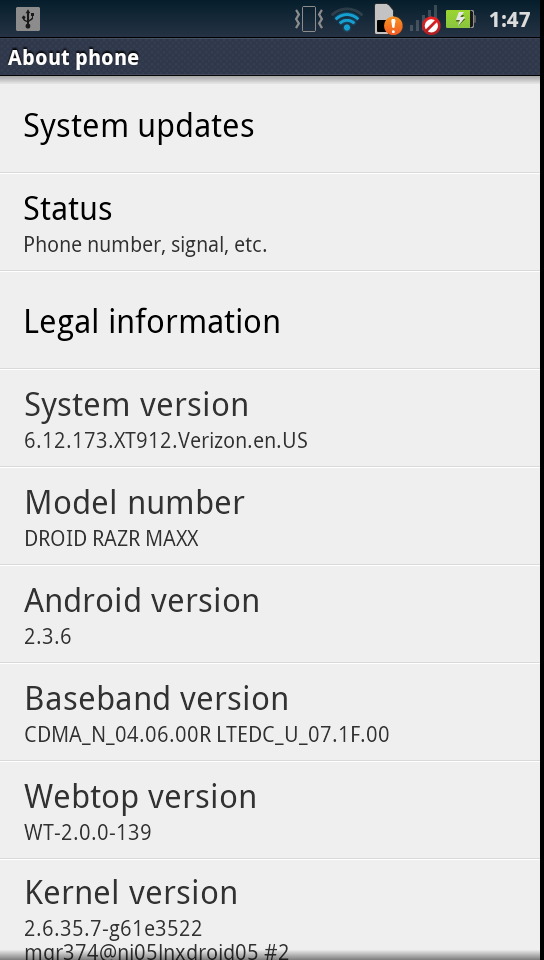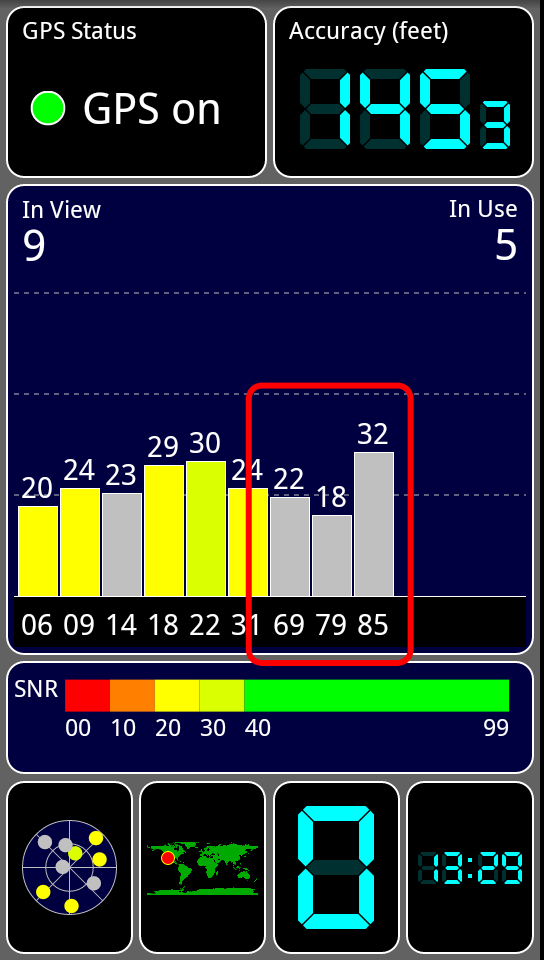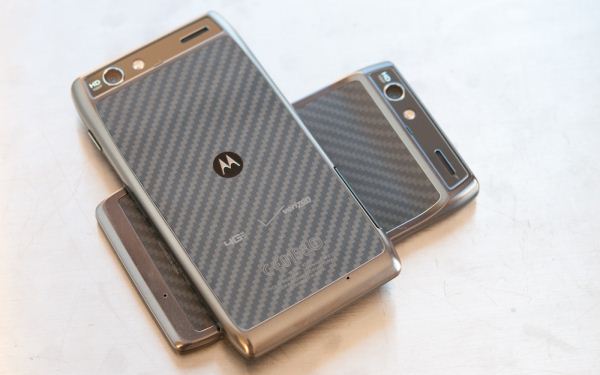Motorola Droid RAZR MAXX Review - 1.8x The Battery
by Brian Klug on February 14, 2012 2:01 PM EST- Posted in
- Smartphones
- Motorola
- Android
- Mobile
- motorola droid RAZR
- RAZR MAXX
- RAZR
Since the RAZR Review
The Droid RAZR and RAZR MAXX as of this writing have been both pushed the same “6.12.173.XT912.Verizon.en.US” update, which makes a number of changes and improvements that mitigate some of the things I complained about in the initial Droid RAZR review. The core Android version is now 2.3.6. I’ve re-run our performance tests, and nothing has really changed here, unsurprisingly.


First, the update changes the Settings page aesthetics slightly, including some icons that weren’t there previously. There’s also a change to some of the other icons on the home screen, and the cDRX features I’ve written about before.
I noted some frustration with the RAZR’s camera app in the original review, this has been significantly improved in the latest update. Stability is much improved, UI items no longer completely disappear and the camera app hasn’t crashed at all. In addition I no longer see the RAZR miss focus entirely like I did before, which was a big problem at times.
GNSS
Some other OEMs have written about GLONASS support on their hardware, and I forgot to note in the initial RAZR review that this device also includes GNSS (GPS+GLONASS) support the same way courtesy the MDM6600. Until recently basically all satellite based location has used GPS, which consists of a constellation of 27 satellites. GLONASS is its Russian cousin, with 24 satellites. The two can be used in conjunction to get faster 3D fixes, better coverage, and greater accuracy. We'll see more and more GNSS solutions start shipping in 2012 as well.

GLONASS satellites are used here, circled in red
If you fire up GPS Test, satellites numbered 65-88 are GLONASS. Qualcomm’s GNSS only uses GLONASS when there either aren’t enough visible GPS satellites for a fix, or SNR is bad (basically an urban canyon or indoors scenario), so you’ll often see a set of bars pop in or out depending on how good the normal GPS SNR is. This implementation is the same for all of the Qualcomm SoCs and MDMs that include GNSS support.
Final Words
If you want a smartphone that’s uncompromising about battery life and also includes 4G LTE connectivity, the Droid RAZR MAXX is a no brainer, especially over the Droid RAZR sans MAXX. There’s just no other device out there right now that lasts as long and isn't a feature phone or crippled in some way, and in a world where everything is being fabbed on a 4x nm process, battery life at the high end is entirely a function of battery capacity. Until 28nm SoCs and basebands start arriving in devices later this year, things aren’t going to change much, either - you just need a big battery to post the kind of numbers the MAXX does in our battery life tests.
The RAZR MAXX is a device after my own heart, as I almost always end up buying or seeking out whatever extended battery option is available for whatever device I carry. There’s just nothing more frustrating than constantly worrying about having a dead device with no charger in sight. On trips and visits to cafes with intermittent or barely working WiFi, hotspot battery life ends up being probably the most important thing to me, and remains the big battery life equalizer.
Right now on Verizon the top tier of Android phones in my mind really is a two horse race. On one side is the Galaxy Nexus which is awesome purely because it’s running Android 4.0 with no customizations. On the other hand, the RAZR MAXX is a device with very similar specifications (and the same CPU, GPU, and clocks), but with a much larger battery. That's a big simplification, but superficially those are the biggest factors. As soon as the RAZR MAXX gets its Android 4.0 update, I think it’ll be hard to argue in favor of the Galaxy Nexus over the MAXX for most customers, though the former will continue to be the platform that gets updates first, comes with an unlocked bootloader, making it the obvious enthusiast choice. For people who don't find themselves presented with a charger at the end of every day, or can't charge the device on a regular schedule, the MAXX is also a no-brainer.
If anything, I hope that the RAZR MAXX sets a new trend for devices with internal batteries, which a lot of recent devices have started shipping with. If you’re going to make a device and seal the battery inside, at least make it huge.











45 Comments
View All Comments
jjj - Tuesday, February 14, 2012 - link
Thanks for the charging time test,was curious about that.As for more devices with large battery maybe we'll see more but it's not all about sealing the battery,Moto did a couple of other things like use a thinner screen and populate only 1 side of the PCB.Ofc the touch layers are about to get thinner and Gorilla 2 is also a bit thinner so in theory it is getting easier to fit a larger battery.Problem is that the industry thinks 1 day battery life is the sweetspot and the marketing guys like thinner much better.so chances are that we'll see 6mm phones or less soon but not many will race to include a large battery in a thicker package.There is a next step soon to make em even thinner but,i'll let the phone makers figure that out .
jontech - Tuesday, February 14, 2012 - link
I liked the feel of the RZR but the thickness at the top was simply poor design. Now with a more uniform feel I want to see itmutatio - Tuesday, February 14, 2012 - link
I know, right? I've been sick of the lopsided top end since the designs first came out. I find it a bit ironic that a non-iPhone device went with the built-in battery as that's one of the mantras the Apple haters immediately scream about. This phone sets a high bar for talk time, for sure, though I personally use my cellphone for mostly data related activities.pedro441 - Tuesday, February 14, 2012 - link
So if I'm not worried about computational advantages offered by the new processors and care strictly about battery life on LTE (and recognizing that predicting the future is hard...) which will better get me through the day?shabby - Tuesday, February 14, 2012 - link
My crystal ball says wait for the future to come and then decide.mcnabney - Wednesday, February 15, 2012 - link
At what time in the past 25 years has something bigger, faster, sleeker, smarter, or better NOT just been around the corner?There will be something even COOLER coming out after Krait. There always is. If you need a new device, unless you actually NEED what the next generation has, just buy the device that is best for you now.
pedro441 - Wednesday, February 15, 2012 - link
Yes, I take your point. I will submit, however, that the battery life of successive devices has not been subject to the rapid improvement that those other characteristics you mention have shown.nafhan - Thursday, February 16, 2012 - link
If you're not worried about compute advantages. Get this. I'd guess most phones built on 28nm CPU's will use the lower power draw to allow smaller cheaper batteries not two days of battery life (at least not at first).The Razor MAXX also the obvious advantage of being available NOW instead of some unspecified date in the future. :)
piroroadkill - Tuesday, February 14, 2012 - link
You packed in a massive battery whilst still letting the device remain thin.I sincerely hope every other manufacturer follows suit, fast.
michael2k - Tuesday, February 14, 2012 - link
In both the 3G and 4G tests, we see very close to the expected scaling, and the RAZR MAXX easily captures the top spot.Actually, in the 3G test we show the iPhone 4S has the top spot at 9.85H, so you either have a mistake in text or your graph is wrong.